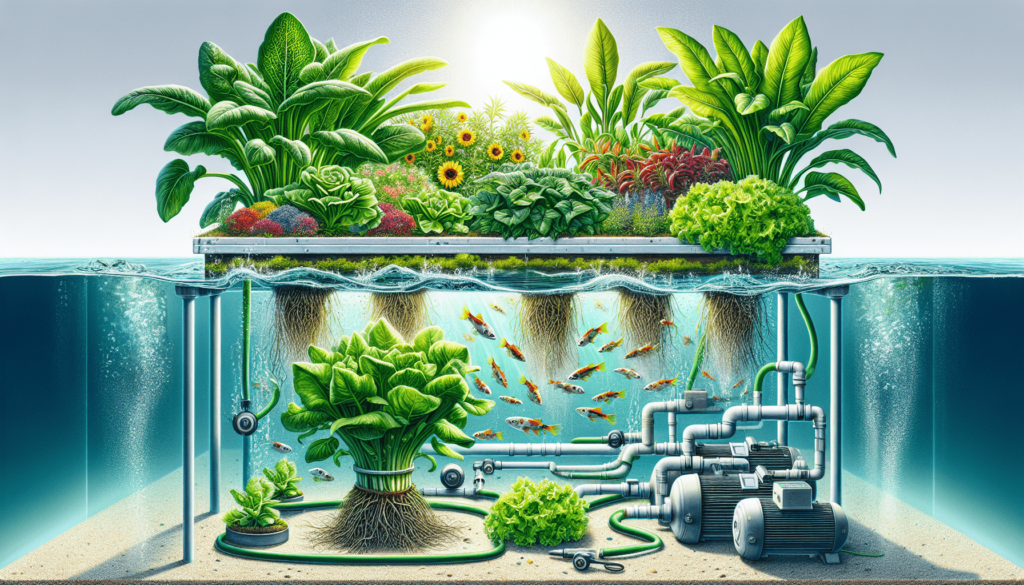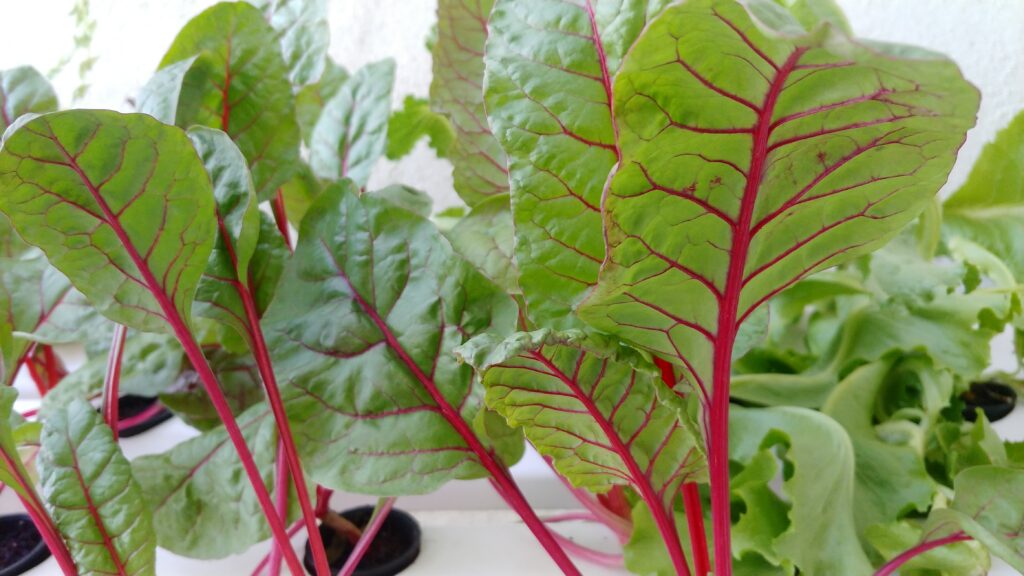Imagine having fresh, homegrown vegetables and fish all year round, without the limitations of traditional soil-based gardening. In this article, we explore the possibilities of using aquaponics or hydroponics systems, whether it’s to maintain a sustainable food source throughout the year or simply as a seasonal gardening project. Discover the benefits, challenges, and potential of these innovative growing methods that allow you to enjoy the fruits of your labor in any season.

Advantages of Aquaponics and Hydroponics
Year-round cultivation
One of the major advantages of both aquaponics and hydroponics is the ability to cultivate crops year-round. Unlike traditional soil-based farming, which is often limited to specific seasons or climates, aquaponics and hydroponics allow you to control the growing conditions, giving you the flexibility to produce crops throughout the year. This is particularly beneficial for those who are looking to have a consistent supply of fresh produce regardless of the external weather conditions.
Flexible growing conditions
Aquaponics and hydroponics offer the advantage of flexible growing conditions. With soil-less farming methods, you have the ability to create the optimal environment for your crops, taking into consideration factors such as temperature, lighting, and air circulation. This level of control allows you to tailor the growing conditions to the specific requirements of different plant species, boosting their growth and overall productivity.
Reduced need for water and soil
Another significant advantage of aquaponics and hydroponics is the reduced need for water and soil. In traditional farming, a substantial amount of water is required as it seeps into the soil to reach the roots of the plants. However, in aquaponics, the water is recirculated within the system, significantly minimizing water usage. Similarly, hydroponics eliminates the need for soil altogether, replacing it with a nutrient solution that is directly delivered to the roots. This not only saves water but also makes the farming process more sustainable, as it reduces soil erosion and nutrient runoff.
Efficient use of space
Aquaponics and hydroponics are known for their efficient use of space. These farming methods can be set up in a variety of spaces, including urban environments where land may be limited. By utilizing vertical farming techniques, where plants are grown in stacked layers or shelves, you can maximize the use of available space. This is particularly valuable in densely populated areas, where land is scarce and expensive. With aquaponics and hydroponics, you can cultivate a large quantity of crops in a relatively small area, making the most out of your available space.
Considerations for Year-round Cultivation
Temperature control
To successfully cultivate crops year-round in aquaponics and hydroponics, temperature control is crucial. Different plant species have specific temperature requirements for optimal growth, and it’s important to provide them with the ideal conditions. This can be achieved through the use of heating or cooling systems, depending on the climate and the specific needs of the plants. Monitoring and maintaining the temperature within the preferred range will help ensure consistent growth and maximize crop production throughout the year.
Lighting requirements
Lighting is another critical consideration for year-round cultivation in aquaponics and hydroponics. Plants need a certain amount and quality of light to carry out photosynthesis effectively. While natural sunlight is always preferred, artificial lighting can be used to supplement or replace natural light, especially in areas with limited access to sunlight or during the winter months. LED grow lights have become increasingly popular in indoor farming due to their energy efficiency and customizable light spectrums that can be tailored to the specific needs of different plant species.
Air circulation and CO2 levels
In addition to temperature and lighting, proper air circulation and CO2 levels are essential for successful year-round cultivation. Plants need a constant supply of fresh air to exchange gases, and carbon dioxide (CO2) is crucial for photosynthesis. Ensuring proper ventilation and airflow within the growing area is necessary to prevent the build-up of excessive heat or humidity, which can negatively impact plant health. Additionally, monitoring and maintaining the optimal CO2 levels will promote healthy growth and maximize crop yields.
Monitoring and maintenance
Year-round cultivation in aquaponics and hydroponics requires diligent monitoring and maintenance. Regularly monitoring various factors such as pH levels of the water, nutrient solution concentration, temperature, humidity, and CO2 levels is essential to ensure the well-being of your plants. Any deviations from the optimal ranges should be promptly addressed to prevent any negative impacts on crop growth. Additionally, routine maintenance tasks, such as cleaning the system, checking for clogged lines, and inspecting equipment, should be performed regularly to keep the system running smoothly and efficiently.
Seasonal Considerations for Aquaponics
Fish species and their seasonal needs
In aquaponics, fish play a vital role in providing the nutrients necessary for plant growth. Different fish species have specific seasonal needs, and it’s important to consider these when planning for year-round cultivation. Some fish may require warmer water temperatures during certain seasons, while others may be more resilient to colder conditions. By selecting fish species that are well-suited to the local climate and seasonal variations, you can maintain a healthy and balanced ecosystem within your aquaponics system throughout the year.
Plant selection for different seasons
Just like fish, plant selection is also an important consideration for seasonal aquaponics. Some plant varieties thrive in cooler temperatures, while others prefer warmer conditions. By carefully selecting crops that are suited for each season, you can ensure continuous and successful cultivation. Additionally, rotating crops throughout the year can help optimize nutrient utilization and prevent the build-up of pests or diseases that may affect specific plants. Planning your crop selection and rotation in advance will allow you to maximize your yield potential and maintain a diverse and productive aquaponics system year-round.
Adjusting nutrient solution ratios
The nutrient solution, which provides essential minerals and nutrients to the plants in hydroponics, may need to be adjusted seasonally in aquaponics. As the feeding patterns and metabolism of the fish may vary with the changing seasons, it’s important to monitor the nutrient levels in the water and adjust the feeding of the fish accordingly. This, in turn, will affect the nutrient levels available for the plants. Adapting the nutrient solution ratios to match the seasonal variations will help maintain optimal conditions for plant growth and ensure a healthy aquaponics system year-round.
Seasonal Considerations for Hydroponics
Lighting adjustments for different seasons
In hydroponics, where plants are grown without soil and solely rely on a nutrient solution, lighting plays a crucial role. Natural sunlight availability varies with the seasons, and adjustments may be required to ensure plants receive the required amount of light throughout the year. During winter or in areas with limited sunlight, increasing the duration and intensity of artificial lighting can compensate for the reduced natural light. Conversely, in areas with abundant sunlight during certain seasons, adjusting the lighting schedule, or shading techniques may be necessary to prevent excessive heat or light stress on the plants.
Nutrient solution adjustments
In hydroponics, the nutrient solution is a vital component that provides plants with the necessary minerals and nutrients for growth. However, the nutrient requirements of plants may vary with the seasons. For example, during the flowering or fruiting stage, plants may require higher levels of potassium and phosphorus. Conversely, during the vegetative stage, higher levels of nitrogen may be needed. Monitoring and adjusting the nutrient solution composition based on the seasonal requirements of your plants will ensure optimal nutrient availability and promote healthy growth and productivity.
Temperature and humidity control
Maintaining the ideal temperature and humidity levels is essential for successful year-round hydroponic cultivation. During colder seasons, additional heating may be required to keep the growing environment within the optimal temperature range. Conversely, excessive heat can negatively impact plant health, so proper ventilation and cooling systems may be necessary in warmer seasons. Additionally, managing humidity levels is crucial to prevent the development of fungal diseases or pathogens. Implementing proper temperature and humidity control measures will contribute to the overall success and productivity of your hydroponic system throughout the year.

Cost Analysis and Return on Investment
Initial setup expenses
When considering aquaponics or hydroponics, it’s important to assess the initial setup expenses involved. Both systems require various components, such as tanks, grow beds, pumps, and lighting systems, which can contribute to the overall initial cost. Additionally, factors such as the size of the system, automation levels, and the need for environmental control equipment will impact the total setup expenses. By carefully planning and budgeting for these costs, you can determine the feasibility of implementing an aquaponics or hydroponics system and make informed investment decisions.
Operational costs
In addition to the initial setup expenses, it’s important to consider the ongoing operational costs of aquaponics and hydroponics. These costs include items such as fish feed, nutrient solutions, electricity for lighting and environmental control systems, water consumption, and routine maintenance. While aquaponics systems may have additional costs associated with fish care and management, hydroponics systems typically require more inputs in terms of nutrient solutions. By estimating the ongoing operational costs, you can assess the financial viability and long-term sustainability of your aquaponics or hydroponics venture.
Potential crop yields and profits
One of the key considerations for any farming venture is the potential crop yields and profits. Aquaponics and hydroponics have the advantage of higher crop yields compared to traditional soil-based farming, thanks to the optimized growing conditions and efficient resource utilization. However, calculating the potential crop yields and profits is influenced by various factors, including the choice of plant species, market demand, selling prices, and operational costs. Conducting market research, calculating potential yields, and assessing the demand and pricing in your target market will help you determine the revenue potential and profitability of your aquaponics or hydroponics operation.
Case Studies
Year-round aquaponics/hydroponics farms
Several successful year-round aquaponics and hydroponics farms serve as inspiring case studies for aspiring farmers. These farms demonstrate the potential for consistent crop production and profitability throughout the year. By implementing advanced technologies, leveraging automation, and carefully managing the growing conditions, these farms have achieved remarkable results. Through case studies, aspiring aquaponics and hydroponics farmers can gain valuable insights and learn best practices from experienced industry leaders, enabling them to overcome challenges and replicate success in their own operations.
Seasonal aquaponics/hydroponics gardens
In addition to year-round farming, aquaponics and hydroponics can also be used for seasonal cultivation. Seasonal gardens can provide an opportunity to cultivate specific plant varieties that are best suited for certain seasons. For example, cold-tolerant crops can be grown during the winter, while heat-loving plants can thrive during the summer. Seasonal aquaponics and hydroponics gardens allow for a diverse range of crops and offer the flexibility to adapt to changing market demands and consumer preferences. These gardens can complement existing traditional farming practices or be standalone operations, providing farmers with additional income streams and a more extended growing season.
Climate and Location Factors
Determining feasibility based on climate
The climate and geographical location play a crucial role in the feasibility of aquaponics and hydroponics. These farming methods can be implemented in a wide range of climates, from tropical to temperate regions, by adjusting various environmental factors. However, extreme climates with prolonged periods of extreme temperatures or limited sunlight may present additional challenges. Assessing the climatic conditions, average sunlight hours, and temperature ranges in your specific region will help determine the feasibility of year-round or seasonal aquaponics or hydroponics farming and enable you to make informed decisions.
Accounting for specific location characteristics
Besides climate, specific location characteristics should also be taken into account when planning for aquaponics or hydroponics. Factors such as access to water sources, availability of electricity, proximity to markets, and local regulatory frameworks can significantly impact the viability and success of your farming operation. Conducting thorough research and understanding the unique characteristics of your location will allow you to make informed decisions and implement strategies that maximize the potential for successful aquaponics or hydroponics farming.
Educational Opportunities and Resources
Aquaponics and hydroponics workshops
For those interested in learning more about aquaponics and hydroponics, attending workshops and training sessions can be highly beneficial. Many organizations and educational institutions offer hands-on workshops that cover various aspects of aquaponics and hydroponics, including system design, management, and crop cultivation. These workshops provide valuable opportunities to gain practical knowledge, learn from experts in the field, and network with other individuals who share similar interests. By participating in educational workshops, you can enhance your understanding of these farming methods and acquire the necessary skills to implement and manage your own aquaponics or hydroponics system.
Online forums and communities
Online forums and communities dedicated to aquaponics and hydroponics can serve as valuable resources for information and support. These platforms allow individuals to connect with experienced practitioners, ask questions, share ideas, and learn from others’ experiences. Online forums provide a virtual space for collaboration and knowledge exchange, offering a supportive community for beginners and experienced farmers alike. By actively participating in these communities, you can gain insights, find solutions to common challenges, and stay updated with the latest trends and advancements in aquaponics and hydroponics.
Agricultural extension services
Agricultural extension services provided by government agencies and universities are an excellent resource for information, training, and support in aquaponics and hydroponics. These services offer guidance on a wide range of agricultural practices, including soil-less farming methods. They often conduct research, disseminate information through publications, and provide technical assistance to farmers. By reaching out to your local agricultural extension office, you can access resources, expertise, and potential funding opportunities that can support your aquaponics or hydroponics journey.
Regulatory Considerations
Permits and licenses
Before starting an aquaponics or hydroponics operation, it’s important to ensure compliance with all necessary permits and licenses. The specific requirements may vary depending on your location and the scale of your farming operation. In some cases, permits may be needed for the installation of equipment, water usage, fish cultivation, or the sale of farm products. It’s essential to research and understand the local regulations, consult with relevant authorities, and obtain the required permits and licenses to operate your aquaponics or hydroponics business legally and smoothly.
Compliance with environmental regulations
Aquaponics and hydroponics have the advantage of being environmentally friendly farming methods. Nevertheless, it’s essential to be aware of and comply with any specific environmental regulations that apply to these farming practices. These may include regulations related to the discharge of water, the use of additives or chemicals, waste management, or the protection of natural habitats. By ensuring compliance with environmental regulations, you can contribute to sustainable farming practices and demonstrate responsible stewardship of the environment.
Conclusion
Aquaponics and hydroponics offer numerous advantages for both year-round and seasonal cultivation. With the ability to control growing conditions, reduce water and soil usage, and maximize space efficiency, these soil-less farming methods provide opportunities for consistent crop production, higher yields, and increased profitability. However, careful consideration of factors such as temperature, lighting, air circulation, and nutrient solutions is required for successful year-round cultivation. Seasonal considerations, crop selection, and adjustment of environmental parameters allow for adaptation to different seasonal conditions.
Cost analysis and return on investment assessments are important for determining the financial feasibility of aquaponics and hydroponics ventures. Case studies provide valuable insights and best practices for both year-round farming and seasonal gardens. Considering climate and location factors, as well as accessing educational opportunities and resources, such as workshops, online forums, and agricultural extension services, will further enhance your knowledge and skills in aquaponics and hydroponics. Understanding and complying with regulatory requirements ensures legal operation and responsible environmental practices.
Whether you choose to cultivate crops year-round or seasonally, aquaponics and hydroponics provide exciting opportunities for sustainable and efficient farming practices that can contribute to food security and ecological resilience. By embracing these innovative farming methods, you can embark on a fulfilling journey in soil-less agriculture and enjoy the numerous advantages they offer.


